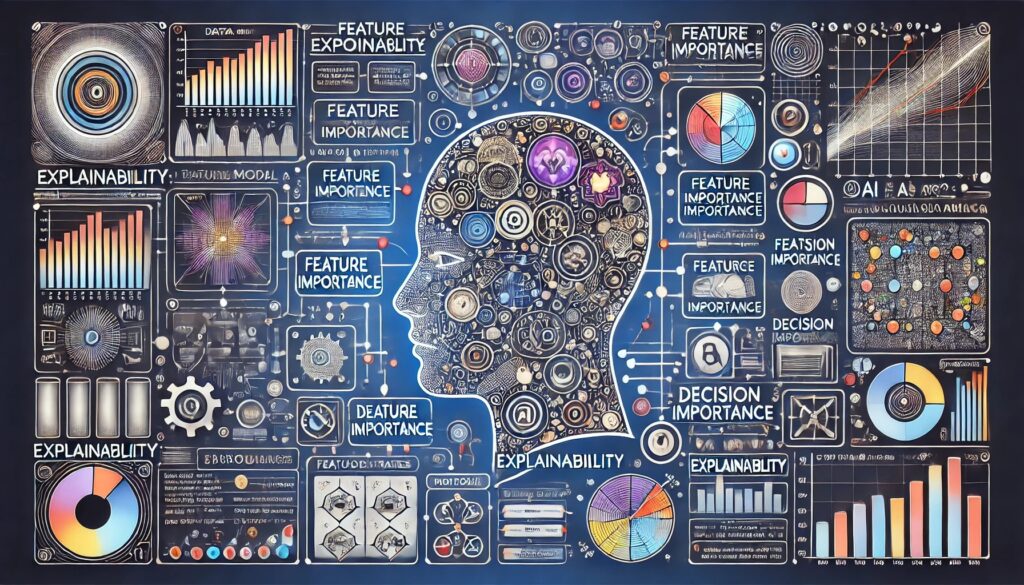
Machine learning (ML) has become a cornerstone of innovation.
From personalized recommendations to autonomous vehicles, it is transforming industries. However, many ML models—especially deep learning systems—operate as “black boxes,” meaning their decision-making processes are often opaque and hard to decipher.
This lack of interpretability raises concerns in fields like healthcare and finance, where high-stakes decisions rely on machine output. We need to ask: if we don’t understand how a model arrives at its conclusions, how can we trust it?
That’s where the twin concepts of interpretability and explainability come into play. Let’s dive into why these two concepts are crucial for the future of ethical AI.
The Difference Between Interpretability and Explainability
Interpretability and explainability are often used interchangeably, but they aren’t quite the same. Interpretability refers to the ability to understand the inner workings of the model itself—essentially, can we peek inside the machine’s brain and make sense of it?
On the other hand, explainability is about the output. Can the model’s decisions be made clear to end users, even if the model’s inner workings remain complex? In simpler terms, interpretability focuses on how it works, while explainability is more about why it works.

Why Interpretability is Critical for Trust
Building trust in machine learning models is vital, especially in sensitive applications like criminal justice or medical diagnosis. Without transparent models, stakeholders will struggle to trust them. Imagine a medical professional using a model to recommend treatment but unable to explain to the patient why that treatment is being suggested. It raises ethical red flags.
Additionally, interpretability plays a role in debugging and improving models. If we can’t figure out why a model is making errors, it’s nearly impossible to correct those mistakes.
Ethical AI: A Case for Explainability
In industries such as healthcare, financial services, and autonomous systems, explainability becomes a non-negotiable requirement. For example, regulatory frameworks like GDPR mandate the “right to explanation,” meaning individuals impacted by automated decisions have a right to understand why a decision was made.
Explainability ensures models align with ethical standards and reduces the risk of bias. When we can see how a model arrived at its conclusion, we are in a better position to spot and eliminate hidden biases, thus promoting fairness.
Improving Model Accountability Through Explainability
Accountability is essential when it comes to AI governance. If a machine learning model is responsible for a life-altering decision, such as approving or denying a loan application, organizations must be able to explain and defend those decisions.
This is where explainability tools, like LIME (Local Interpretable Model-agnostic Explanations) and SHAP (SHapley Additive exPlanations), come into play. These tools help break down model decisions and make them more understandable to humans, fostering greater accountability.
Real-World Impacts of Poor Explainability
The risks of not prioritizing explainability can have devastating consequences. Consider an autonomous vehicle misinterpreting road conditions due to a flaw in its machine learning algorithm. Without explainability, it may be impossible to identify the root cause of the error before it happens again.
Similarly, in the world of finance, an unexplained model error can result in significant financial losses for businesses or unfair credit denial to individuals.
How Interpretability Enhances Transparency
One of the major criticisms of AI systems is their lack of transparency. Interpretability bridges this gap, making the model’s internal logic clearer to its creators.
For instance, interpretable models like decision trees and linear regressions are easy to understand because they break down decisions in a step-by-step format. Even though these models may not be as powerful as deep neural networks, their transparency offers significant advantages in terms of trust and accountability.
The Role of Explainability in Complex Models
Complex models, such as neural networks, are notoriously difficult to interpret. However, these models are often the ones delivering breakthroughs in fields like natural language processing and image recognition.
Explainability techniques become essential in these cases. By offering insights into how these “black boxes” work, tools like SHAP provide a layer of understanding that allows developers to fine-tune the models, while also offering users a way to comprehend the outputs.
Bridging the Gap Between Users and Machines
Explainability isn’t just for the technical elite. In fact, one of its primary purposes is to make AI systems more accessible to non-technical users. A bank’s customers should be able to understand why their loan was denied, just as a doctor should trust the diagnosis from an AI model.

By enhancing explainability, we empower both users and stakeholders to interact with machine learning in a more meaningful way. This also fosters a sense of control and understanding, which is crucial for user acceptance.
Balancing Model Performance with Interpretability
There is often a trade-off between model performance and interpretability. More interpretable models, like decision trees, may be simpler and easier to understand but less accurate than complex neural networks. On the other hand, highly complex models may offer superior performance but at the cost of interpretability.
The challenge lies in finding the right balance. In some cases, sacrificing a bit of accuracy for a more interpretable model could be the more ethical and practical choice, especially in critical applications.
The Future of Machine Learning: More Transparent AI
As machine learning continues to advance, the demand for more transparent AI is increasing. The future of AI isn’t just about higher accuracy; it’s about responsible, interpretable, and explainable models that people can trust.
We can expect regulatory bodies to implement even stricter rules around explainability, especially as AI begins to permeate more areas of daily life.
Moving Toward Explainable AI (XAI)
The growing interest in Explainable AI (XAI) signals a shift in how we develop and use machine learning models. Explainability is now becoming a core feature, not an afterthought, in the model development process.

By integrating interpretability and explainability at the design stage, developers can create models that are both powerful and transparent, addressing both the ethical and technical challenges that lie ahead.
Explainability: A Solution to Bias in Machine Learning
Bias in machine learning is a hot topic, and rightly so. Explainable AI offers a way to spot and address these biases. By understanding how models make decisions, we can uncover hidden prejudices and work to mitigate them before they cause harm.
This is especially important when it comes to applications like facial recognition, where unchecked biases could lead to significant privacy violations or wrongful accusations.
Leveraging Interpretability for Improved Decision-Making
The ability to interpret machine learning models offers a distinct advantage in decision-making processes. For businesses, it means having more confidence in their automated systems. For consumers, it means understanding the decisions that affect them.
In the future, interpretability will likely become a key factor in determining which machine learning models are adopted and which are not.
Interpretability in High-Stakes Environments
When machine learning models are deployed in high-stakes environments, the demand for interpretability escalates. In areas like healthcare, autonomous driving, and criminal justice, the decisions made by these models can have life-altering consequences.
For example, imagine an ML system misdiagnosing a patient due to an unclear reasoning process. Without interpretability, doctors would be hesitant to trust such systems, potentially avoiding them altogether.
Thus, interpretable models help ensure that we can safely and effectively integrate AI into critical areas.
The Legal Implications of Explainability
With increasing reliance on automated decision-making, the legal system is starting to catch up. Regulations like the General Data Protection Regulation (GDPR) in Europe require companies to provide explanations for automated decisions, especially when those decisions significantly affect individuals.
Failure to explain model decisions can result in regulatory backlash, including hefty fines or lawsuits. Companies in industries like finance, healthcare, and insurance are particularly vulnerable to these legal risks. Explainability, therefore, isn’t just a best practice—it’s becoming a legal requirement.
Explainability and Consumer Trust
The use of machine learning in consumer applications is growing. Whether it’s deciding what ad you see on social media or recommending your next Netflix binge, these systems are embedded in everyday life.
However, with great power comes great responsibility. Consumer trust is easily eroded when decisions appear random or biased. Imagine a customer being denied a loan or flagged by fraud detection without any clear explanation. Transparency fosters trust and leads to better relationships between businesses and consumers.
Tools to Enhance Explainability
In recent years, a range of tools has been developed to boost the explainability of machine learning models. Some of the most popular include:
- LIME: Local Interpretable Model-agnostic Explanations. This tool explains individual predictions of any machine learning model.
- SHAP: SHapley Additive exPlanations. It attributes each feature’s contribution to the final decision, giving a detailed explanation of how inputs affect the outcome.
These tools are particularly valuable for making complex models more digestible to both developers and end users.
Balancing Privacy and Explainability
An interesting challenge arises when you try to balance privacy concerns with the need for explainability. Some ML models, particularly in sensitive industries like healthcare or finance, handle private data. The more explainable a model is, the more it might expose details about individuals’ private information.
To address this, some researchers are focusing on developing methods for privacy-preserving machine learning. These techniques allow models to be interpretable without violating data privacy, which is a crucial development for the ethical deployment of AI systems.
FAQs
What are some methods to improve interpretability in machine learning?
Methods to improve interpretability include using simpler models (like decision trees and linear regression), applying techniques such as feature importance analysis, and utilizing tools like SHAP (SHapley Additive exPlanations) and LIME (Local Interpretable Model-agnostic Explanations) to explain predictions from complex models.
Can a machine learning model be both accurate and interpretable?
Yes, a machine learning model can be both accurate and interpretable. While simpler models like decision trees and linear regression are inherently interpretable, complex models can also be made interpretable through the use of specific techniques and tools designed to explain their predictions.
What challenges are associated with interpretability and explainability in machine learning?
Challenges include the complexity of models, the trade-off between model accuracy and interpretability, the potential for misinterpretation of explanations, and the difficulty in explaining highly intricate and opaque models like deep neural networks.
How does explainability impact the deployment of AI in critical sectors?
Explainability impacts the deployment of AI in critical sectors by enhancing trust and acceptance among stakeholders, enabling compliance with regulations, and ensuring that AI systems operate fairly and ethically. It is particularly important in sectors like healthcare, finance, and law where decisions can have significant consequences.
What role does interpretability play in ethical AI?
Interpretability plays a crucial role in ethical AI by allowing stakeholders to understand, trust, and verify the decisions made by AI systems. It helps in identifying and mitigating biases, ensuring fairness, and maintaining accountability in AI applications.
What tools are available for improving model explainability?
Tools for improving model explainability include SHAP, LIME, ELI5, and What-If Tool. These tools help in analyzing and visualizing model predictions, providing insights into how different features influence outcomes.
Why is transparency in machine learning models essential?
Transparency in machine learning models is essential for building trust, ensuring ethical use, facilitating regulatory compliance, and enabling users to understand and challenge the decisions made by AI systems. It helps in making AI more accessible and accountable to all stakeholders.
How can explainability aid in model debugging?
Explainability aids in model debugging by providing insights into how the model makes decisions, allowing data scientists to identify and correct errors, biases, or unexpected behaviors. This helps improve the model’s performance and reliability.
What is the significance of feature importance in model interpretability?
Feature importance measures the impact of each input feature on the model’s predictions. Understanding feature importance helps in interpreting the model’s behavior, verifying its correctness, and ensuring that the model focuses on relevant aspects of the data.
How does regulatory compliance relate to explainability in machine learning?
Regulatory compliance often requires that AI systems provide clear and understandable explanations for their decisions, especially in sensitive areas like finance and healthcare. Explainability ensures that models meet these legal requirements and operate transparently.
How does explainability help in addressing model bias?
Explainability helps in addressing model bias by revealing how different features influence the model’s predictions, allowing data scientists to detect and correct biases. This ensures fair and equitable outcomes across diverse groups.
What is the role of domain experts in enhancing model interpretability?
Domain experts play a crucial role in enhancing model interpretability by providing context and insights into the data and the model’s decisions. Their expertise helps ensure that the model’s predictions are logical and aligned with real-world expectations.
How does explainability affect user trust in AI systems?
Explainability affects user trust in AI systems by making the decision-making process transparent and understandable. When users can see and comprehend how a model reaches its conclusions, they are more likely to trust and accept the AI system.
Conclusion
Interpretability and explainability in machine learning are more than technical requirements; they are fundamental aspects of building trust, ensuring ethical practices, and enhancing decision-making across various domains. As machine learning continues to shape our world, the importance of interpretability and explainability will only grow. Embracing transparent and understandable models will pave the way for a future where AI systems are trusted, reliable, and fair.
For more on this topic, you can explore these resources.